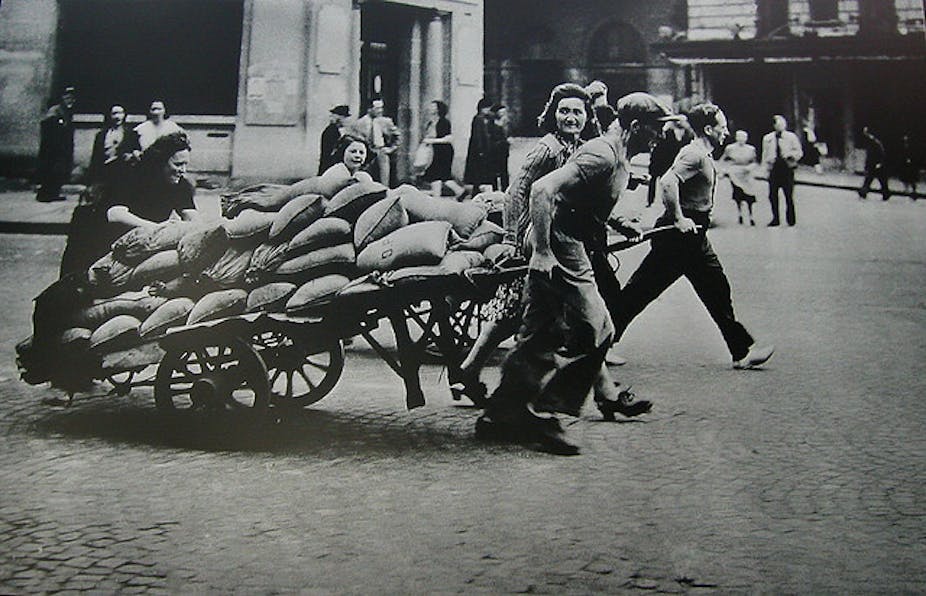The 70th anniversary of D-Day also commemorates the beginning of the end for the Third Reich occupation of France. Starting with the Normandy landings of June 6 1944, Allied troops began to turn the tide on four years of Nazi rule.
The landings in Provence near Toulon on August 15 spearheaded the liberation of the southern departments and sent German troops scurrying back to the north and east. The most symbolic of the liberations, that of Paris, was achieved by August 25 1944.
Internal resistance became more confident and daring as Allied forces encroached on the country. Resistance fighters (they were called the “Maquis” in reference to the French scrub land) came out from the countryside to help, but often prematurely; they were gunned down, and villages deemed to be harbouring “terrorists” were put to fire and sword.
Liberated France was a predominantly female country. Most able-bodied French men were either held in prisoner-of-war camps or had been put to work in German factories to boost the Third Reich’s war effort, only returning some months later when the war was over. The people who witnessed the drama of liberation were therefore mostly women, children and the elderly. It was they who had to suffer the day-to-day hardships of German occupation.
And if the majority of the population did not take sides but simply tried to survive as best they could, there was a small minority who chose to resist. A great many women were among them.
Resistance activity was modelled on military activity, so the women of the Resistance therefore did not usually bear arms. But women across the country made a vital contribution to the Resistance movement, even if full recognition of their central role only came several decades after the events.
Under the radar
Women’s low visibility in French society paradoxically played to their advantage under occupation; it meant they could act as ideal couriers, with no-one, least of all the Germans, suspecting them of carrying important messages, concealing arms and papers in children’s prams, or conveying vital supplies to Resistance members in hiding.

But that same inconspicuousness meant the women of the Resistance were overlooked after the war. Women’s main priority in the immediate post-war years was elsewhere, as they focused on rebuilding family life in an effort to return to normality. They dutifully answered de Gaulle’s call for “12m bouncing babies” to rebuild France.
They themselves remained largely silent about their activities, often demurring to their male comrades, who took full credit for the Resistance’s achievements. Of 1,036 members of the Free French or Resistance honoured by Charles de Gaulle in the Order of Liberation, only six were female.
Yet for French women, who finally gained the vote in October 1944, the Occupation had been an apprenticeship. It allowed many women to gain insights into their own capacities and potential – even if they chose, for the most part, not to pursue it.
More recently, womens’ role in the Resistance has once again come to the fore. In February 2014, President Hollande announced that the ashes of Germaine Tillion and Geneviève de Gaulle, two distinguished resistance heroines, would be interred in the Panthéon, a prestigious national honour. Besides Marie Curie, they will be the Panthéon’s only women. Meanwhile, the French Sénat debated the role played by women in the Resistance in a special dedicated conference last month.
Beyond the Gaullist myth
While few women wielded arms or led resistance networks, there were some who did – like Julia Pirotte, a Belgian woman of Polish Jewish origin. As commander of a communist immigrant resistance group, FTP/MOI, she led the attack on the Marseille Prefecture and documented her activities with remarkable photographs. Her example highlights not just the exceptional roles some women played in fighting the Nazis, but also the fact that Resistance workers were not all French.
In the interests of national unity, Gaullist post-war mythologists propagated the myth that the Resistance in France was primarily French, and that most French people had resisted. These blatant exaggerations were politically expedient; they allowed the country to move forwards after the trauma of Vichy and collaboration. The widely adopted “Gaullist myth” effectively obscured the presence of the many resisters of foreign origin, notably Spanish republicans, Polish and Romanian Jews, Italian anti-fascists and even German anti-Nazis.
Ongoing research drawing on archives across Europe is trying to more precisely chart the contribution these individuals made. As we move towards the 70th anniversary of liberation, the ordinary stories of the people of the Resistance – and women in particular – are still the key to a deeper and healthier understanding of France’s traumatic occupied years.

